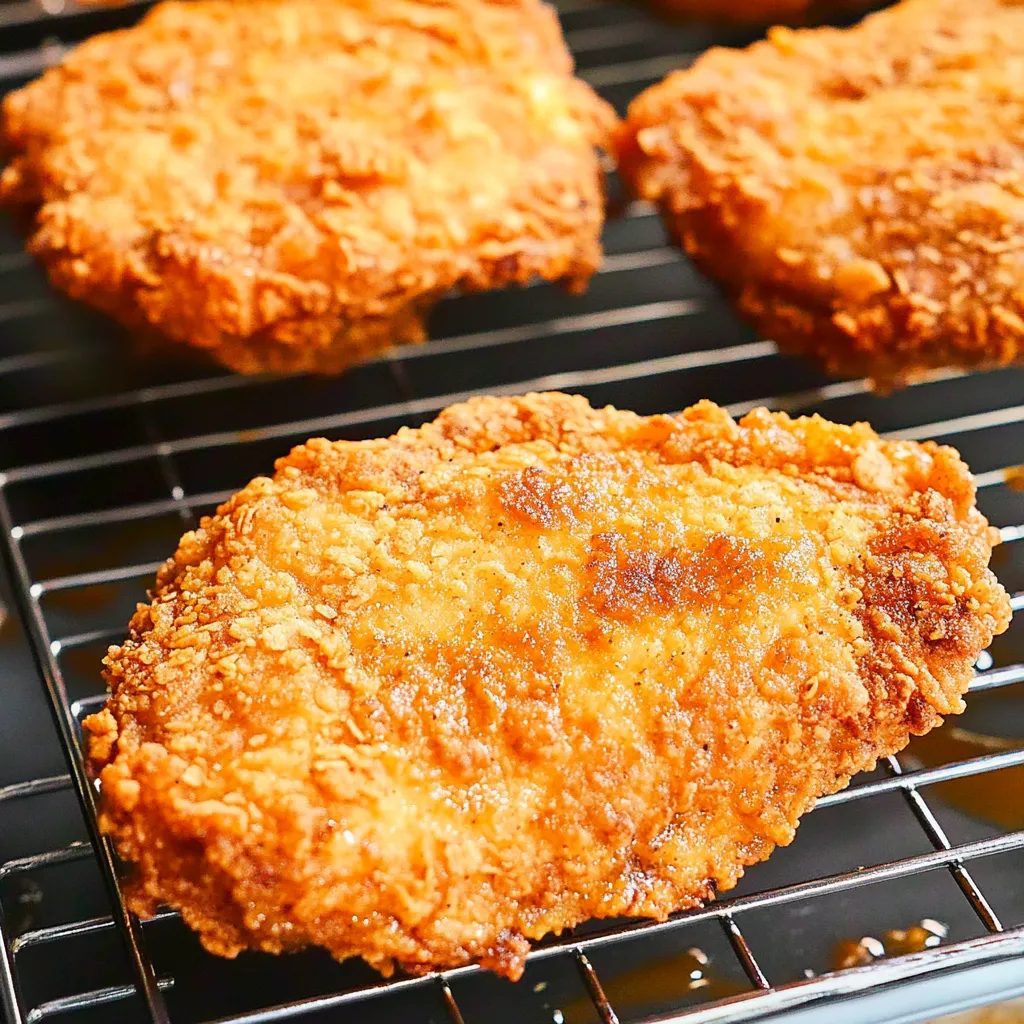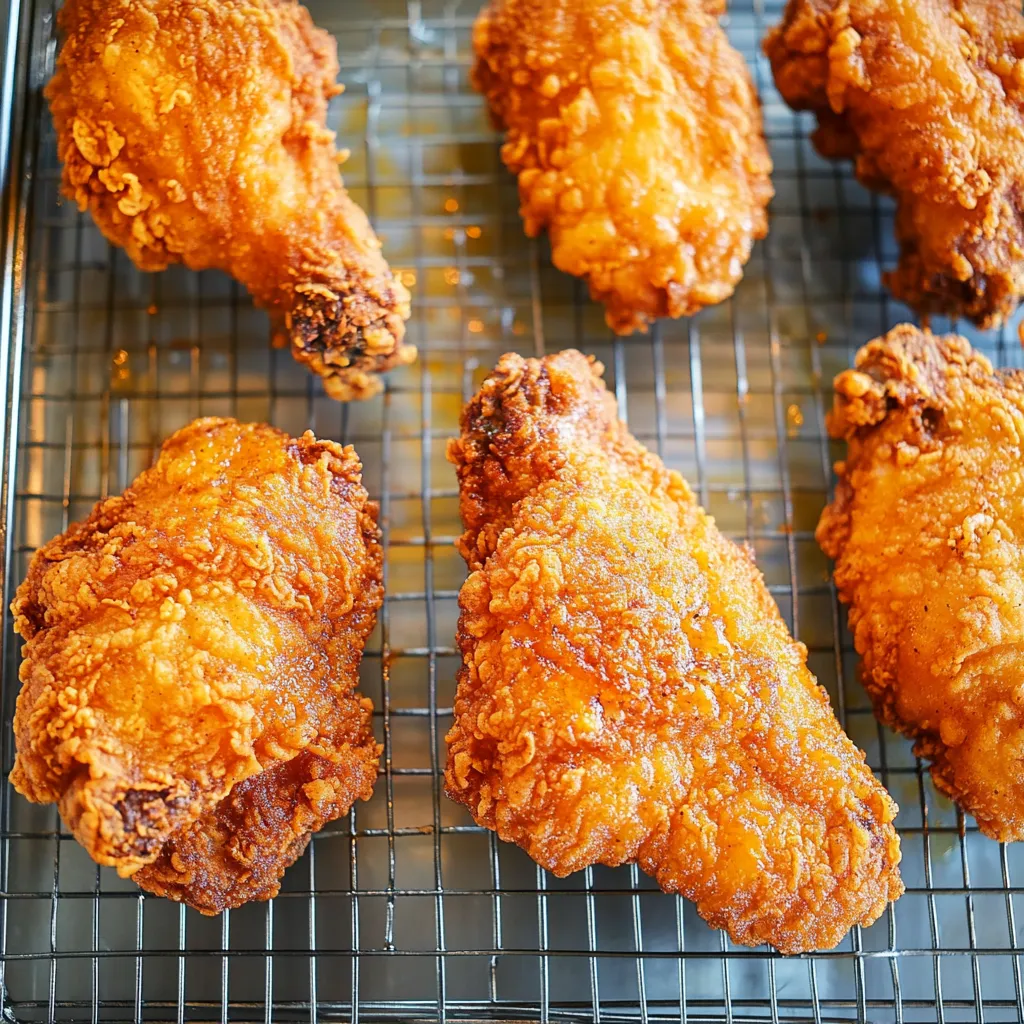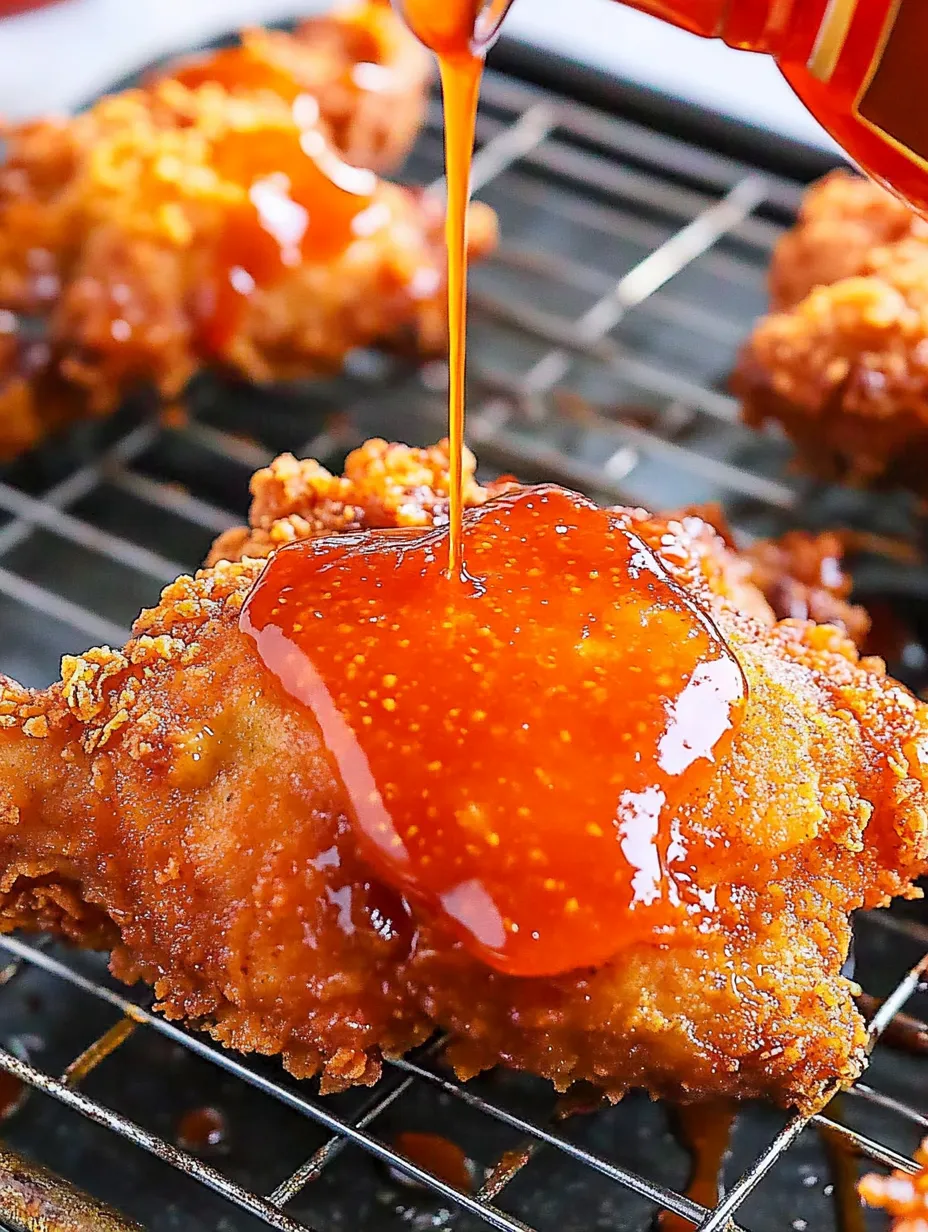 Pin it
Pin it
Southern Comfort Classic
This extraordinary fried chicken transforms humble ingredients into culinary magic through a blend of unexpected flavors and precise technique that creates the perfect balance of crispiness and juiciness. The magic happens in the extended marination that tenderizes the meat while infusing it with subtle tang from pickle juice, followed by a masterfully seasoned coating that crisps to golden perfection in hot oil. I perfected this recipe after countless attempts to recreate the distinctive flavor of my favorite fast food chicken but with greater depth and freshness.
Crunchy Perfection
My journey with this recipe began after moving away from my beloved Southern hometown and its exceptional fried chicken joints. What started as desperate attempts to satisfy cravings evolved into a signature dish that friends and family request specifically. Even my grandmother, with seven decades of fried chicken experience, asked for my technique after her first bite. The marriage of modern ingredients like pickle juice with traditional Southern methods creates something that honors tradition while introducing subtle improvements that make this version unforgettable.
Superior Ingredients
- Bone In Chicken Pieces: Provide superior flavor and juiciness compared to boneless alternatives, with thighs and drumsticks offering the perfect meat to bone ratio
- Buttermilk (2 cups): Creates the essential tenderizing foundation with natural enzymes that break down proteins while contributing subtle tanginess
- Pickle Juice (1/2 cup): Adds unexpected brightness and acidity that penetrates the meat with flavor while further tenderizing through its salt and vinegar content
- Hot Sauce (1/4 cup): Infuses gentle background heat throughout the chicken without overwhelming spiciness while adding vinegar notes that enhance flavor
- All Purpose Flour (3 cups): Forms the primary coating base that provides structure and proper browning characteristics
- Cornstarch (1 cup): The secret to exceptional crispiness that stays crisp longer than flour alone could achieve
- Paprika (2 tablespoons): Contributes beautiful color and sweet pepper flavor without heat that balances the other seasonings
- Cayenne (1 teaspoon): Delivers controlled heat that builds gradually rather than overwhelming the palate immediately
 Pin it
Pin it
Southern Technique
- Marinade Magic:
- Begin this culinary journey with proper chicken preparation and marination, which forms the foundation for exceptional results. In a large glass or ceramic bowl, combine 2 cups buttermilk, 1/2 cup pickle juice from a jar of dill pickles, 1/4 cup hot sauce, 2 beaten eggs, 1 tablespoon kosher salt, and 1 teaspoon black pepper, whisking thoroughly to combine. This unlikely combination creates the perfect pH balance for tenderizing chicken while infusing it with subtle flavor notes that will shine through even after coating and frying. Submerge 3 pounds of chicken pieces completely in this mixture, cover tightly, and refrigerate for at least 4 hours, though overnight marination delivers superior results by allowing the acidic elements to fully penetrate the meat. The buttermilk proteins create a sticky surface that helps the coating adhere while the acids in the pickle juice and hot sauce break down tough muscle fibers for extraordinary tenderness.
- Coating Perfection:
- When ready to cook, create the exceptional coating that will transform into the signature crispy exterior. In a large, shallow dish, combine 3 cups all purpose flour, 1 cup cornstarch, 2 tablespoons paprika, 1 tablespoon garlic powder, 1 tablespoon onion powder, 1 teaspoon cayenne pepper, 1 tablespoon kosher salt, and 1 teaspoon black pepper, whisking thoroughly to distribute all seasonings evenly throughout the dry mixture. The cornstarch is crucial here, as its lighter structure creates a shatteringly crisp texture that stays crisp longer than flour alone could maintain. Working with one piece at a time, remove chicken from the marinade, allowing excess to drip off while preserving some of the thick buttermilk coating that helps the dry ingredients adhere. Dredge thoroughly in the seasoned flour mixture, pressing firmly to create a substantial coating with plenty of craggy edges that will crisp beautifully. For extra crispiness, dip coated pieces briefly back into the marinade and dredge a second time, creating additional texture and ensuring no bare spots remain.
- Frying Excellence:
- Proper frying technique distinguishes exceptional fried chicken from mediocre attempts. Fill a large, heavy Dutch oven or deep cast iron skillet with vegetable or peanut oil to a depth of approximately 3 inches, but no more than halfway up the sides of the vessel for safety. Heat the oil to exactly 325°F as measured with a reliable thermometer, a temperature that might seem low but is ideal for cooking chicken through without burning the coating. Working in small batches to prevent overcrowding, which would lower the oil temperature and create steaming rather than frying, carefully lower 3 to 4 pieces of coated chicken into the hot oil. Maintain the temperature between 315°F and 325°F throughout cooking, adjusting heat as needed. Fry for 12 to 15 minutes, turning occasionally with tongs, until the coating reaches a beautiful golden brown color and the internal temperature reaches 165°F when tested with an instant read thermometer inserted into the thickest part without touching bone.
- Finishing Touches:
- As each batch finishes cooking, transfer to a wire rack set over a baking sheet rather than paper towels, which can create steam that softens the carefully developed crust. Season immediately with a light sprinkle of kosher salt while the coating is still hot, allowing the crystals to adhere to the surface. This final seasoning layer brightens all the flavors and creates the perfect finishing touch. If cooking multiple batches, you can hold the finished chicken in a 200°F oven on the wire rack setup, which maintains crispness while keeping everything warm until serving time. This slight holding period actually improves flavor as the seasonings settle and fully permeate the coating. Serve on a platter lined with checkered paper for authentic presentation, accompanied by traditional Southern sides like mashed potatoes, coleslaw, or flaky biscuits that complement the rich, flavorful chicken perfectly.
I particularly treasure how this recipe connects generations through food traditions. Growing up watching my grandfather tend his cast iron filled with bubbling chicken pieces created some of my most vivid childhood memories. The distinctive sound of that first bite into properly fried chicken triggers an almost Pavlovian response of happiness across age groups. When my teenage nephew showed interest in cooking, this was the first "impressive" recipe we tackled together, creating not just exceptional chicken but lasting kitchen memories. The look of pride on his face when serving his parents crispy golden pieces he'd prepared himself was worth every minute of teaching and any kitchen mess created in the process.
Perfect Pairings
This spectacular chicken welcomes numerous accompaniments that complete the traditional Southern meal experience. For authentic presentation, serve alongside creamy mashed potatoes with chicken gravy and tender collard greens seasoned with a hint of vinegar and bacon. Classic coleslaw provides cooling crunch that balances the rich, warm chicken beautifully. Fresh baked buttermilk biscuits offer the perfect vehicle for sopping up any juices while completing the Southern trinity of biscuits, chicken, and sides. For modern interpretations, consider serving with sweet potato waffle fries and honey butter for dipping both the chicken and potatoes. Summer gatherings call for traditional picnic sides like potato salad, baked beans, and corn on the cob that complement without competing with the star attraction. For beverages, sweet tea served in mason jars creates nostalgic authenticity, while those enjoying adult options might appreciate how craft beer or dry sparkling wine cuts through the richness.
Creative Adaptations
This foundation recipe welcomes numerous variations based on preference or dietary considerations. For those preferring white meat, boneless chicken breasts can be substituted, though cooking time should be reduced to approximately 8 to 10 minutes to prevent dryness. Heat levels adjust easily through cayenne quantity, with spice enthusiasts perhaps doubling the amount while those preferring milder flavors might reduce or eliminate it. Regional variations might incorporate specific seasoning blends, with Cajun versions adding more herbs and heat, while Carolina styles might increase the vinegar notes in both marinade and accompanying sauces. For unique flavor profiles, experiment with different pickle juice varieties, perhaps using bread and butter pickle brine for subtle sweetness or spicy pickle juice for additional heat layers. Those seeking lighter options might try an air fryer adaptation, spraying the coated chicken with oil and cooking at 375°F for approximately to 25 minutes, though the texture differs somewhat from traditional frying.
 Pin it
Pin it
Storage Strategies
While this chicken reaches its absolute pinnacle when freshly fried, proper storage techniques can maintain much of its quality for later enjoyment. Allow any leftover chicken to cool completely to room temperature before refrigerating to prevent condensation that would soften the coating. Store in a single layer in shallow containers rather than stacking pieces, which can crush the delicate crust. Refrigerated chicken keeps well for up to three days when properly stored. For reheating, avoid microwave methods which create soggy, rubbery results. Instead, place refrigerated chicken on a wire rack over a baking sheet in a preheated 375°F oven for 15 to 20 minutes until heated through and recrisped. For exceptional revival of leftover pieces, a few minutes in an air fryer at 350°F restores much of the original texture. Surprisingly, cold leftover fried chicken has its own devoted following and makes excellent picnic fare or midnight snacking straight from the refrigerator.
After perfecting this recipe through countless iterations, I've come to appreciate fried chicken as more than just delicious food but rather as a cultural treasure worth preserving and elevating. What begins as humble ingredients transforms through careful technique into something that creates memorable eating experiences and brings people together around the table with anticipatory smiles. The perfect balance of crispy exterior and juicy, flavorful meat represents culinary harmony that transcends its simple components. While commercial versions certainly have their place, this homemade adaptation delivers deeper flavor complexity and textural perfection that reminds us why cooking from scratch remains worthwhile in a convenience oriented world.
Frequently Asked Questions
- → Can I substitute the buttermilk in this fried chicken recipe?
- Yes, you can make a buttermilk substitute by adding 4 tablespoons of lemon juice or white vinegar to 4 cups of regular milk and letting it sit for 10 minutes until slightly curdled. For a dairy-free option, use 4 cups of unsweetened plain almond or soy milk mixed with 4 tablespoons of lemon juice, plus 2 tablespoons of dairy-free yogurt for thickness. However, real buttermilk provides the best flavor and tenderizing properties. The acidity in buttermilk helps break down proteins in the chicken, resulting in more tender meat, while also adding a subtle tanginess that enhances the overall flavor profile.
- → What's the purpose of pickle juice in the marinade?
- Pickle juice serves several important functions in fried chicken marinade: 1) Its high acidity helps tenderize the meat by breaking down tough protein fibers. 2) It adds a distinctive tangy flavor that complements the richness of fried chicken. 3) The salt and seasonings in pickle juice help the chicken retain moisture during frying. 4) It contains vinegar which, like buttermilk, denatures proteins and improves texture. Many Southern and commercial recipes (including Chick-fil-A's famous chicken) use pickle brine as a secret ingredient. While bread and butter pickle juice adds a slight sweetness, dill pickle juice provides a sharper tang. If you don't have pickle juice, you can substitute with 1/4 cup white vinegar mixed with 1/4 cup water and 1 teaspoon of sugar.
- → Why mix cornstarch with flour for the coating?
- The flour-cornstarch combination is crucial for achieving the perfect fried chicken crust: 1) Cornstarch doesn't contain gluten, so it creates a lighter, more delicate coating compared to using only flour. 2) When cornstarch is heated in oil, it forms a barrier that inhibits oil absorption, resulting in less greasy chicken. 3) Cornstarch creates a distinctively crispy, almost glass-like crunch that stays crispy longer. 4) The combination creates those desirable craggly, crunchy edges and nooks. The ideal ratio is about 50/50 as used in this recipe - enough flour to provide structure and browning, with enough cornstarch to maximize crispiness. For even more textural contrast, you can add 1-2 tablespoons of rice flour or baking powder to the mix.
- → How do I ensure my fried chicken stays crispy?
- To maintain maximum crispiness in your fried chicken: 1) Let the coated chicken rest on a wire rack for 15-20 minutes before frying - this helps the coating adhere better and prevents it from falling off during frying. 2) Maintain proper oil temperature between 325-350°F throughout frying - use a thermometer and adjust heat as needed. 3) Don't overcrowd the pan, which lowers oil temperature and creates steam. 4) Place finished chicken on a wire rack rather than paper towels, which trap steam and soften the crust. 5) Keep chicken warm in a 200°F oven on a wire rack if making multiple batches. 6) For leftovers, refrigerate uncovered until cool, then cover. Reheat at 375°F in an oven or air fryer for 10-15 minutes until hot and crispy again, rather than using the microwave which will create steam.
- → What can I use instead of the Bayou City seasonings?
- If you don't have access to Bayou City seasonings, you can create your own substitutes: For Bayou City Garlic Pepper, combine 1 tablespoon garlic powder, 1 teaspoon black pepper, 1/2 teaspoon salt, and 1/4 teaspoon dried parsley. For Bayou City All Purpose Seasoning, mix 1 teaspoon each of paprika, onion powder, and garlic powder, plus 1/2 teaspoon each of dried oregano, dried thyme, black pepper, and salt. Alternatively, other commercial options like Lawry's Seasoned Salt, Tony Chachere's Creole Seasoning, or Old Bay can work well in this recipe. The key is to ensure your substitution has a good balance of salt, garlic, herbs, and a touch of heat to create that classic Southern fried chicken flavor profile.
- → How do I know when the chicken is fully cooked?
- Properly cooked fried chicken requires both visual cues and temperature verification: 1) Use a meat thermometer inserted into the thickest part of the meat (without touching bone) - chicken is safe when it reaches 165°F (74°C). 2) The exterior should be golden brown to dark golden brown, not pale or burnt. 3) Clear juices should run when pierced with a fork (bloody or pink juices indicate it's undercooked). 4) Different parts cook at different rates - wings and smaller pieces may finish in 8-10 minutes, while thighs and breasts take 12-15 minutes. 5) If your chicken is browning too quickly before reaching safe temperature, lower heat to 325°F and continue cooking. 6) Allow chicken to rest for 5-10 minutes after frying for the juices to redistribute and for carryover cooking to finish the process.
